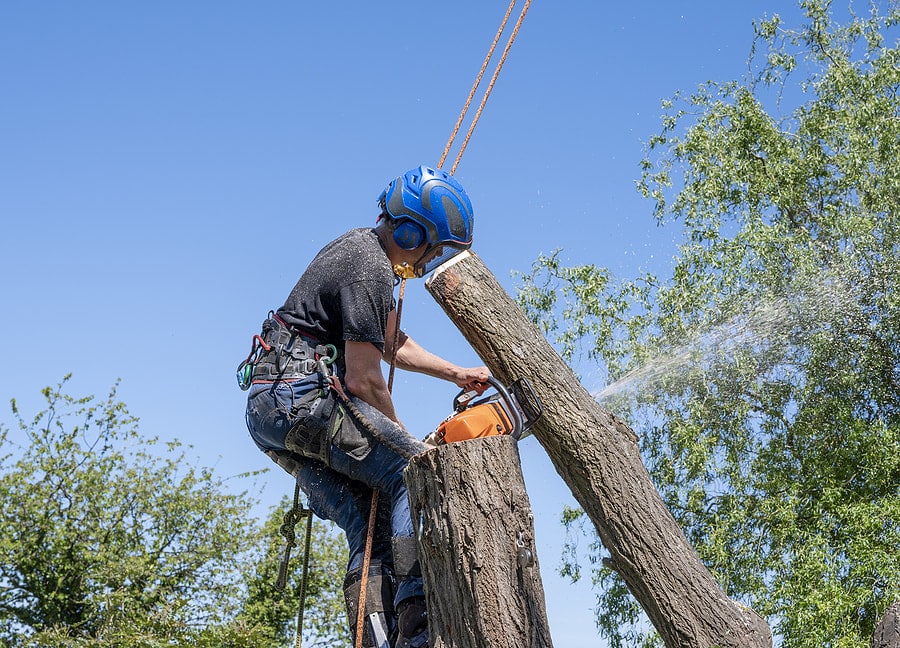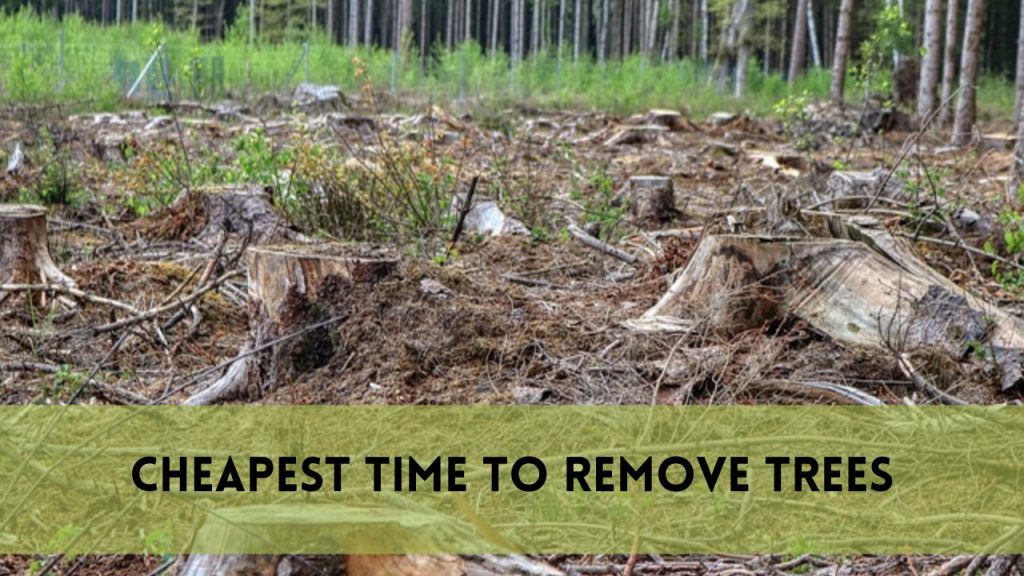When it comes to real estate, property value is a crucial factor that can be influenced by numerous variables. One such factor that often raises eyebrows and sparks debate is the removal of trees from a property. Trees, with their majestic presence and environmental benefits, have long been celebrated as assets to any landscape. However, there are instances where removing trees becomes a necessity or a strategic decision for homeowners and developers.
The million-dollar question is: does removing trees increase property value, or does it have the opposite effect? In this blog post, we will delve into the intricate relationship between trees and property value, exploring the various factors at play and offering insights that can help you make informed decisions about the greenery on your real estate investment.
Does Removing Trees Increase Property Value?
Trees play a multifaceted role in determining the value of residential properties, transcending their mere physical presence. These botanical giants influence various aspects of a property’s worth, ranging from enhancing its aesthetic appeal to offering critical environmental benefits and even contributing to the psychological well-being of its inhabitants.
Aesthetic Appeal
1. Curb Appeal
- Trees are a cornerstone of curb appeal, a crucial factor when selling or renting a property. The first impression that a property makes often stems from its exterior, and trees significantly contribute to this impression.
- Well-maintained trees, with their lush canopies and seasonal transformations, create an inviting ambiance that draws in potential buyers or renters.
- They offer shade, texture, and color, enhancing the overall visual appeal of the property.
2. Landscaping and Aesthetics
- Trees serve as natural, living sculptures within the landscape, providing an ever-changing backdrop to the property.
- They bring nature’s beauty to your doorstep, with blossoming flowers in spring, vibrant greenery in summer, and a stunning display of foliage colors in the fall.
- By incorporating trees into the property’s landscaping design, homeowners can create shaded areas, serene groves, or scenic viewpoints, thereby augmenting both the functionality and aesthetics of their property.
Environmental Benefits
1. Air Quality Improvement
- Trees act as natural air purifiers, absorbing pollutants like carbon dioxide, sulfur dioxide, and particulate matter from the atmosphere. They also release oxygen, promoting cleaner air.
- Improved air quality translates to healthier living conditions, which can positively influence property values. In areas with better air quality, residents may experience fewer respiratory issues and allergies.
2. Temperature Regulation
- Trees offer natural cooling during hot summers by providing shade. This shade can significantly reduce the need for air conditioning, resulting in lower energy bills for homeowners.
- During the winter months, trees act as effective windbreaks, reducing heat loss and further decreasing energy expenses.
Psychological and Health Benefits
1. Stress Reduction
- The presence of trees in residential areas has been associated with reduced stress levels among residents. The calming effect of nature can mitigate the pressures of urban living.
- Just gazing at trees or taking leisurely strolls through tree-lined streets can contribute to a sense of well-being and relaxation.
2. Mental Well-being
- Proximity to green spaces and trees can have a positive impact on mental health. Access to nature provides opportunities for outdoor recreation, exercise, and relaxation.
- Living in areas with an abundance of trees and greenery may increase property desirability, as they offer residents a reprieve from the hustle and bustle of city life.
Factors Impacting Property Value
The influence of trees on property value is nuanced and subject to a range of factors that can either amplify or diminish their impact. When evaluating the potential effects of tree removal or preservation on property worth, it’s essential to consider these contextual elements.
Location and Climate
1. Urban vs. Rural Areas
- The interplay between trees and property value differs between urban and rural settings. In urban areas, trees often enhance property value by providing much-needed greenery in densely populated neighborhoods.
- In rural areas, large wooded lots may be highly sought after, as they offer privacy and recreational opportunities, potentially driving up property values.
2. Climate Considerations
- Climate plays a pivotal role in how trees influence property value. In warmer climates, trees that provide shade can significantly reduce cooling costs during hot summers, thus adding to property value.
- Conversely, in colder climates, trees may act as effective windbreaks, reducing heating costs and increasing the appeal of properties.
Tree Species and Health
1. Native vs. Non-Native Species
- The choice of tree species can profoundly affect property value. Native species are typically better adapted to local conditions and ecosystems, requiring less maintenance and offering greater environmental benefits.
- Non-native or invasive species can pose challenges by potentially threatening local flora and fauna, which can have a detrimental impact on property value if not managed properly.
2. Tree Maintenance
- The health and upkeep of trees are pivotal factors. Well-maintained trees, free from diseases and pests, are more likely to enhance property value.
- Conversely, neglected or diseased trees can pose safety hazards, reduce aesthetics, and decrease property desirability, potentially leading to a decrease in property value.
Property Size and Layout
1. Lot Size
- The size of the property lot plays a crucial role in how trees affect property value. On larger lots, mature trees may enhance privacy and provide a sense of seclusion, which can be highly desirable.
- On smaller lots, the placement and size of trees must be carefully considered to avoid obstructing views, reducing usable outdoor space, or posing safety hazards.
2. Tree Placement
- The location of trees on the property is paramount. Trees that provide shade to outdoor living areas, such as patios and decks, can increase property value by making these spaces more comfortable and appealing.
- However, trees that obstruct essential views or encroach on structures may have a negative impact on property value, as they can limit the functionality and aesthetics of the property.
The Expected Effect of Tree Expulsion
Property Style and Control Allure
One of the most prompt and perceptible impacts of tree evacuation is the adjustment of a property’s feel and check request. As examined before, trees frequently improve the visual allure of a property, giving a lavish and welcoming scene. Eliminating trees can modify the property’s general appearance, and the effect can be positive or negative, contingent upon different variables.
Positive Effect: At times, tree evacuation can further develop style assuming that the trees were ailing, congested, or outwardly unappealing. Eliminating such trees can make a cleaner, more manicured look that might be liked by certain purchasers. Moreover, assuming that tree expulsion takes into consideration finishing or structural upgrades, it can improve the property’s general allure.
Adverse consequence: Then again, assuming full grown and sound trees are eliminated without reasonable substitutions, the property might lose its appeal and remarkable person. This can prompt diminished control requests and a likely decrease in property estimation, as the property may never again hang out in the area.
4.2 Property Support Expenses
Tree evacuation can likewise affect property support costs. While the facts confirm that tree upkeep (pruning, bug control, and so on.) can be a continuous cost, the expense of evacuation can be significant. Land owners ought to think about the drawn out monetary ramifications of tree expulsion.
Cost of Evacuation: The underlying expense of tree expulsion can change generally contingent upon variables, for example, tree size, area, and availability. Stump evacuation or crushing may likewise be fundamental, adding to the cost. Land owners ought to acquire statements from legitimate tree expulsion administrations and consider these costs their choice.
Support Reserve funds: Then again, eliminating high-support trees could prompt decreased continuous upkeep costs. Land owners ought to gauge the forthright evacuation cost against the possible reserve funds in tree care to decide the generally monetary effect.
4.3 Ecological Effect
Tree evacuation can have ecological outcomes, which can impact property estimation in naturally cognizant business sectors. Trees assume a significant part in carbon sequestration and neighborhood environments. Their expulsion can upset these regular cycles and influence the property’s eco-amicability.
Positive Natural Effect: Eliminating intrusive or non-local species that hurt the nearby environment might be seen emphatically. Supplanting them with local, biologically valuable plants can upgrade the property’s natural profile and appeal to eco-cognizant purchasers
Negative Natural Effect: On the other side, aimless tree expulsion, particularly in biologically delicate regions, can prompt territory obliteration and adversely influence nearby natural life. In locales with severe natural guidelines, land owners might confront legitimate ramifications for unreasonable tree expulsion.
Area and Market Patterns
The likely effect of tree evacuation on property estimation can likewise be affected by neighborhood and market patterns. In certain areas, mature trees might be profoundly esteemed, and their evacuation could prompt a decrease in property estimations. Alternatively, in regions where tree evacuation is normal because of development or remodel, the effect might be less critical.
Neighborhood Patterns: Property estimations can be impacted by the aggregate inclinations of an area. On the off chance that most properties have very much kept up with trees, eliminating them could make a property less beneficial in examination.
Market Patterns: Housing market patterns can likewise assume a part. In certain business sectors, purchasers might focus on tree-rich properties, able to pay a premium for the additional advantages. In others, factors like area or property size could offset the presence of trees in deciding worth.
Housing Business sector Patterns and Tree Effect
Effect on Property Posting Costs
The connection among trees and property estimation can change essentially based on current housing market patterns. One vital sign of this relationship is the effect of trees on property posting costs.
Research has shown that in many business sectors, properties with very much kept up with and decisively established trees can order higher posting costs.
Cost Premium: In regions where trees are exceptionally esteemed, properties with mature trees and very much finished yards frequently get a cost premium. Purchasers will pay something else for the tasteful and natural advantages that trees give.
Market Interest: The degree of interest for tree-rich properties in the market assumes a significant part. On the off chance that a specific area or locale has a popularity for homes with tree-lined roads or lush parcels, property estimations in those areas might be emphatically impacted by trees.
Purchaser Inclinations and Tree-Rich Conditions
Understanding purchaser inclinations is fundamental while assessing the effect of trees on property estimation. Numerous purchasers look for homes in tree-rich conditions in light of multiple factors:
Beautiful Magnificence: Purchasers are frequently attracted to beautiful settings with trees, nurseries, and plant life. These regular components add to a feeling of serenity and excellence that can upgrade a property’s allure.
Shade and Solace: Trees that give shade and normal cooling are appealing to purchasers, particularly in locales with warm environments. These elements can make a property more agreeable and energy-productive.
Wellbeing and Prosperity: Progressively, purchasers are focusing on properties that advance prosperity. Closeness to nature, including trees and green spaces, can decidedly affect mental and actual wellbeing, making such properties more alluring.
Impact of Neighborhood Guidelines and Metropolitan Preparation
Neighborhood guidelines and metropolitan arranging drives can fundamentally influence the effect of trees on property estimation. A few districts have severe tree conservation mandates and drafting guidelines that safeguard trees and green spaces. These guidelines can impact the general person of neighborhoods and property estimations.
Tree Security: In regions where tree security is fundamentally important, property estimates might be decidedly impacted as purchasers are guaranteed that tree-rich scenes will be kept up with.
Metropolitan Turn of events: In metropolitan regions, city arranging that accentuates green spaces and tree-lined roads can improve the allure of neighborhoods. Properties here might encounter expanded requests and higher qualities.
Thought of Future Development
Land owners ought to likewise think about the potential for future development and improvement in their areas. Assuming that an area is encountering a fast turn of events, saving trees might turn out to be much more basic as new development can prompt tree evacuation and changes in the nearby scene.
Long haul Worth: Properties with all around saved trees might hold their worth better over the long run as they keep up with their appeal in evolving areas.
Local area Allure: Neighborhoods with a wealth of trees frequently have areas of strength for any local area bid. Purchasers looking for a feeling of having a place and association with nature might pay something else for properties in such regions.
FAQs
Are there particular tree animal types that are viewed as more significant for property estimation improvement?
Indeed, certain tree species are for the most part viewed as more significant for upgrading property estimation. Local trees, very much adjusted to the nearby environment, and those that offer stylish excellence, like blooming trees or hardwoods, are frequently liked. In any case, the apparent worth of explicit tree species can shift by area and market patterns.
Could I at any point eliminate a tree on the off chance that it’s hurting my property, such as lifting walkways or harming establishments?
Generally speaking, indeed, you can eliminate a tree that is harming your property. Security and property conservation frequently come first. Notwithstanding, it’s critical to really look at nearby guidelines and talk with experts to survey what is happening appropriately and investigate possible options before expulsion.
Will eliminating trees for a superior perspective on the sea or mountains essentially increment my property’s estimation?
While further developed perspectives can improve property request, the effect on property estimation relies upon different elements, including the market, area, and the inclinations of likely purchasers.
A few purchasers might focus on sees and pay more, yet it’s fundamental to consider the general effect on style and property estimation while eliminating trees for sees.
Do property estimations increase more in metropolitan regions with tree-lined roads, or is the effect more noteworthy in rural or country settings?
The effect of tree-lined roads on property estimations can shift by area and market patterns. In metropolitan regions, trees can upgrade the attractiveness of neighborhoods and add to higher property estimations.
In rural and rustic settings, trees frequently assume an essential part in establishing a serene and appealing climate, which can likewise emphatically impact property estimations.
How might I guarantee that my choice to eliminate trees lines up with the drawn out supportability and ecological cognizance of my local area?
To guarantee your tree expulsion choice lines up with maintainability and local area values, consider establishing substitution trees, particularly local species that help neighborhood environments.
Furthermore, talk with neighborhood arborists and follow any civil tree conservation guidelines. Drawing in with neighborhood natural drives can likewise help add to your local area’s eco-cognizance.
Conclusion
In conclusion, the impact of trees on property value is nuanced and context-dependent. Trees are not merely assets to be weighed solely in monetary terms; they are living organisms that contribute to the quality of life and well-being of communities. Striking a balance between property enhancement and environmental responsibility is the key to realizing the full potential of trees in the realm of real estate. As we continue to evolve in our understanding of sustainable living, responsible tree management remains a crucial element in the ever-evolving landscape of property valuation and urban development.




